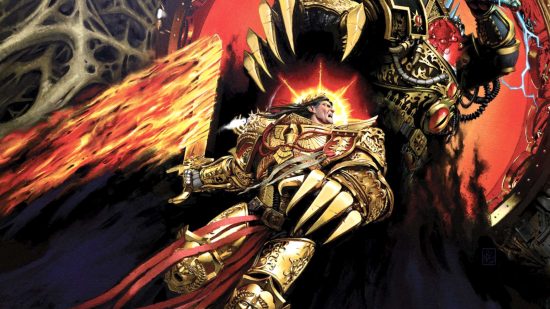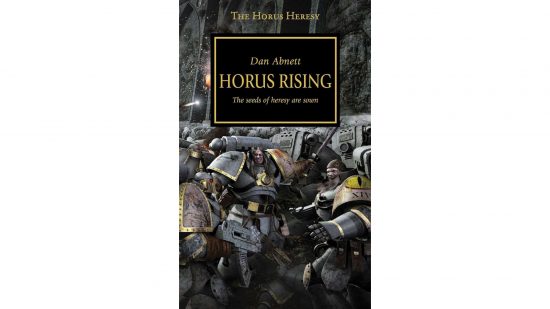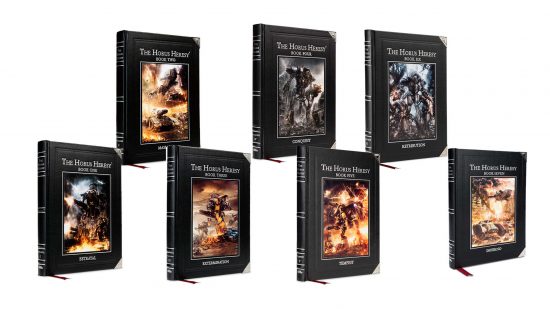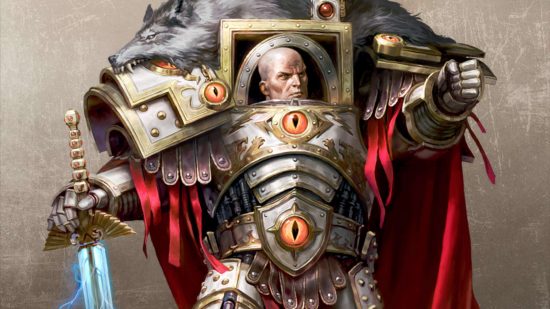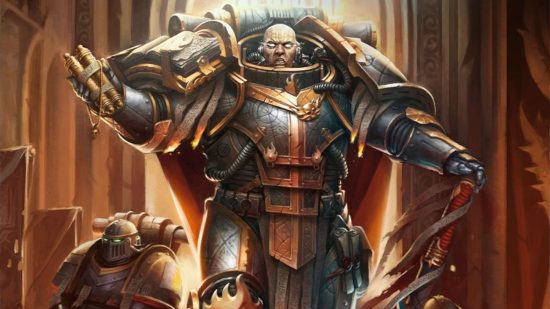The Horus Heresy is the most significant event in the history of the Warhammer 40,000 universe. In the 31st millennium, just as the Emperor’s Great Crusade to unite the scattered worlds of humanity into the Imperium of Man neared completion, Warmaster Horus turned upon the Emperor and plunged the galaxy into civil war.
Many parts of the Warhammer 40k universe trace their origins to the Horus Heresy. The totalitarian Imperium of Man of the 41st millennium is as awful as it is, in part, because of the terrible sacrifices required to prevent the Warmaster’s victory. Greatest of those was the Emperor of Mankind‘s nigh-fatal wounding during his final duel with Horus. Though he secured the Imperium’s victory, the Emperor was left a husk, interred upon the Golden Throne and no longer able to direct his people towards their destiny.
The Horus Heresy has been explored in a huge series of novels and short story anthologies. It is also the setting for several miniature wargames, past and present. This guide introduces you to the books you need to read in order to understand the Horus Heresy, the wargames of the same name, and the in-universe origins of the whole, tragic war.
The Horus Heresy book series
The Horus Heresy book series is almost complete, and will run to 64 main entries: 54 novels and short story anthologies in the Horus Heresy series, plus 10 books in the Siege of Terra miniseries that brings the whole saga to its end.
That’s a lot of books, and that’s not all of it. There are three Siege of Terra novellas which wrap up three substantial narrative threads. The graphic novel Macragge’s Honour plugs a small gap in the main Horus Heresy series. There are seventeen (and counting) novels in the Horus Heresy Primarchs series, set (mostly) during the Great Crusade.
Then there are extra novels and novellas set in the timeline that aren’t numbered entries, like Valdor: Birth of the Imperium, or the Horus Heresy: Heirs of the Emperor anthology. Not to mention some as-yet uncollected Short Stories.
Reading all of that will give you a massive understanding of the Horus Heresy, but it’s not a complete picture. Large amounts of Horus Heresy lore has been printed in wargames rulebooks, particularly the nine massive, expensive, out-of-print ‘Black Books’ for the first edition of the Horus Heresy wargame.
The Black Books focused on the military aspects of the conflict, rather than the interpersonal drama, but did cover some truly critical events: the Dropsite Massacre at Istvaan V is described briefly in several Horus Heresy novels, but explained in great depth in Black Book Two: Massacre.
With so much information out there, and some of the information being in out-of-print collector’s items, it’s unfeasible to read everything from the Horus Heresy. If you want help navigating the mass of Horus Heresy novels, check out Wargamer’s guide to the best Horus Heresy book order.

Warhammer: The Horus Heresy wargame
The Warhammer: The Horus Heresy wargame is a spin-off from Warhammer 40,000. Like Warhammer 40k it uses armies of toy soldiers to recreate massive battles between rival forces. However Warhammer: The Horus Heresy has its own ruleset, and does not feature all of the Warhammer 40k factions.
The Horus Heresy rules are a fork of the seventh edition Warhammer 40k rules. A major difference between it and regular 40k is that damage is resolved against vehicles and infantry in a different way. Weak weapons are incapable of harming well-armored vehicles and tough units like dreadnoughts.

Both ranged and melee combat are very different. In 40k most units put out a predictable amount of damage, but in Horus Heresy weapons need to be brought to bear against an effective foe. Melees can be grinding stalemates or sweeping victories, and a unit might suffer relatively few casualties and still be swept from the field by a victorious foe if its morale fails.
The biggest difference is in force composition. Horus Heresy is largely focused on battles between the Space Marine legions. The Mechanicum of Mars, Solar Auxilia, Militia and Cults, and Daemons, all have rules, but don’t have plastic model ranges, so they’re only really suited to collectors with the budget to buy expensive Forge World models. There are no official rules for Xenos factions.
Other Horus Heresy Wargames
Games Workshop makes three other Horus Heresy wargames. These are all in ‘Epic’ scale; miniatures are roughly ¼ the size of their Warhammer 40k counterparts. This allows for battles between huge armies or very large war engines that wouldn’t be practical in the ‘Heroic 28mm’ scale used by regular 40k.

Adeptus Titanicus
Adeptus Titanicus is a game of battles between Warhammer Titans. These enormous walking war engines are heavily armed and armored, equipped with weaponry usually mounted on spacecraft, and covered in protective void shields, as well as incredibly thick armor.
You field relatively few units in a game of Adeptus Titanicus, but each one has a massive impact. Massive Warlord Titans can strip away an enemy’s shields in a single barrage before coring them out with a Volcano cannon, while nimble Warhounds can stride outside the enemy field of fire and deliver punishing shots to their flanks.
Titans don’t die quickly, taking hit after hit as they become progressively less stable, lurching around the battlefield with crippled systems. A damaged Titan might rebel against its princeps control and obey the directives of its machine spirit, or even explode in a catastrophic reactor meltdown.

Legions Imperialis
Games Workshop announced Legions Imperialis earlier in 2023 with a release date at some point this year. This is a game of massed combat between huge armies of infantry, tanks, walkers, artillery, aircraft, and even Titans.
Previews for Warhammer Legions Imperialis have revealed miniature versions of many iconic Horus Heresy units, from Land Raiders to Legion Jetbikes to Medusa artillery tanks. Games Workshop has also revealed that it will feature destructible terrain, which has us so excited we’ve written a guide to your options when it comes to building teeny-weeny Legions Imperialis terrain to play on.

Aeronautica Imperialis
Aeronautica Imperialis is a wargame of dogfights and bombing missions in the far future. Played on a hex-grid, players control a wing of fighter craft, bombers, and troop transports, attempting to complete their objective while surviving the attentions of the enemy.
Originally released as a Warhammer 40k spin-off, Games Workshop is currently only producing Horus Heresy era-appropriate miniatures and rules for the game. Aeronautica Imperialis figures are completely compatible with Legions Imperialis.
Origins of the Horus Heresy
Around the year 30,000, a warlord known as the Emperor of Mankind united the techno-barbarian tribes of Terra, the ruined planet once known as Earth. A master of genetic alchemy, he crafted superhuman warriors to aid him in his conquest. Before he could finish the greatest of these entities, the Primarchs, their gestation caskets were scattered across the galaxy by an unknown force.
Using genetic material from the lost Primarchs, the Emperor crafted the Space Marine Legions, mass-produced superhuman warriors. With their might, and the industrial might of the tech priests of Mars, he led a Great Crusade into the starts to reunite the lost worlds of humanity. In the process he rediscovered his lost Primarchs, who recognised the Emperor as their father.
The first to be found was Horus Lupercal, who he gave control of the XVIth, ‘Lunar Wolves’ Legion. Throughout the Great Crusade the Lunar Wolves were at the forefront of every conflict, smashing Xenos empires and reuniting more worlds than any other Marine force.
After breaking the back of the largest Ork empire in the Galaxy, the Emperor gave the mantle of Warmaster to Horus, and with it control of the Crusade. The Emperor retreated to Terra to commence a great and secret work. Though honoured by the Emperor’s gift, Horus was troubled, feeling abandoned by his father. At the Emperor’s suggestion, he renamed his Legion the Sons of Horus.
Unbeknownst to any, the powers of Chaos had already begun to worm their way into the heart of several Space Marine legions. Lorgar, Primarch of the Word Bearers, had once worshipped the Emperor as a divine entity. The Emperor spurned his worship, demanding conquest rather than reverence. Seeking spiritual revelation, his former mentor Kor Phaeron and advisor Erebus introduced him to the worship of Chaos. The Word Bearers would go on to seed secretive Chaos lodges throughout many Legions, including the Lunar Wolves.
Shortly after Horus was made Warmaster, Erebus of the Word Bearers joined his entourage, and began to amplify his doubts, even sabotaging diplomatic negotiations with a human empire that might have been brought into the Imperial fold without violence, in order to steal a deadly relic known as the Athame.
Word reached Horus’ fleet of a rebellion by an Imperial governor on the planet Davin. Travelling there with all haste, Horus personally led the reprisal mission against the rebellious planetary governor, who had taken sanctuary on the planet’s moon. Supernatural and inexplicable plague had overrun the moon, and the governor was a grotesquely swollen monstrosity – armed with the Athame.
In the fight that followed the cursed blade nicked the Warmaster’s flesh – enough to send him into a devastating and rapidly degenerating coma. Distraught, the Sons of Horus were willing to listen to Erebus when he suggested a radical course of action – to entrust the dying Warmaster to a shamanic Lodge on Davin.
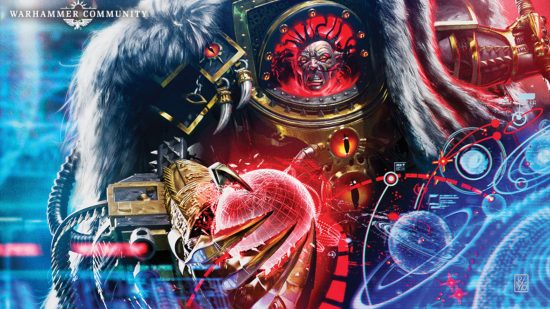
Inside the lodge, Horus entered a dream vision guided by the powers of the warp. Perceiving a dreadful future in which his father was worshipped as a god and his own name was erased from history, Horus listened to the offer of the Chaos powers: in exchange for his loyalty, they would cure him of his ailment. Horus accepted, and so the fate of the galaxy was sealed.
If you want to know what happened next, our guides to the Space Marine Chapters and Legions give the backstory of each of the loyal Primarchs and their legions, while our guides to the Chaos Space Marines, World Eaters, Thousand Sons, and Death Guard explain what those Legions and their Primarchs got up to during the Heresy.
